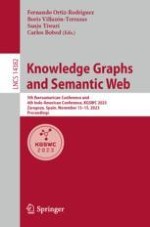2023 | Book
Knowledge Graphs and Semantic Web
5th Iberoamerican Conference and 4th Indo-American Conference, KGSWC 2023, Zaragoza, Spain, November 13–15, 2023, Proceedings
Editors: Fernando Ortiz-Rodriguez, Boris Villazón-Terrazas, Sanju Tiwari, Carlos Bobed
Publisher: Springer Nature Switzerland
Book Series : Lecture Notes in Computer Science
